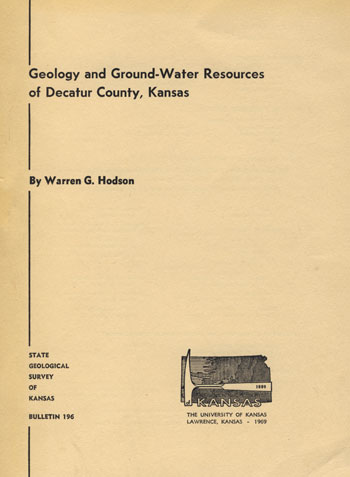Geology and Ground-Water Resources of Decatur County, Kansas
By Warren G. Hodson

Originally published in 1969 as Kansas Geological Survey Bulletin 196. This is, in general, the original text as published. The information has not been updated.
You may also wish to visit our web site on the Decatur County geologic map.
Abstract
Decatur County is a 900-square-mlle area in the High Plains section of northwestern Kansas. The altitude of land surface ranges from about 2,330 to 2,970 feet above mean sea level. The climate is subhumid to semiarid, with a mean annual precipitation of 18.42 inches. The oldest rocks exposed consist of chalk and shale beds of Late Cretaceous age. The Cretaceous rocks crop out in only two small exposures but form the relatively impervious bedrock above which ground water occurs in nearly all the county. The Ogallala Formation of Tertiary (Pliocene) age overlies the Cretaceous rocks in the upland areas and is the most widespread aquifer in the county. Stream erosion has removed the Ogallala Formation along the principal valleys, but streams, through several cycles of alluviation, have subsequently deposited the more permeable sediments in the valleys. Eolian silts of late Pleistocene age mantle much of the upland areas and obscure the stream terraces along the principal valleys.
There are two principal aquifers in the county--the Ogallala Formation that underlies the upland areas and the relatively narrow alluvial deposits in the four major stream valleys. The upland areas have more areal extent than the alluvial valleys, but the highest yielding wells are in the major valleys where most of the irrigation is practiced. Based on population figures and livestock statistics, an estimated 750 to 1,000 acre-feet of ground water is used annually in rural areas for household and livestock purposes. Three cities use a total of about 400 acre-feet of ground water per year. About 17,000 acre-feet of ground water is appropriated for the irrigation of 10,500 acres. Ground water in the county is moderately hard, but its quality is adequate for most purposes.
Kansas Geological Survey, Geology
Placed on web Oct. 8, 2008; originally published Dec. 1969.
Comments to webadmin@kgs.ku.edu
The URL for this page is http://www.kgs.ku.edu/General/Geology/Decatur/index.html